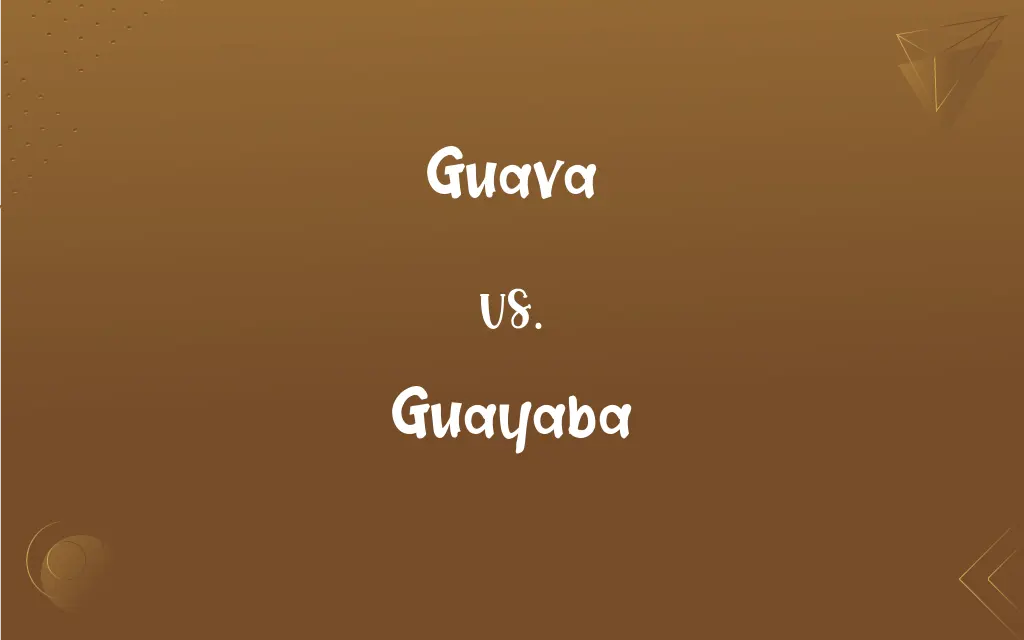Guava vs. Guayaba: What's the Difference?
By Janet White & Harlon Moss || Updated on March 4, 2024
Guava and guayaba refer to the same fruit, known scientifically as Psidium guajava, but the terms are used in different languages: guava in English and guayaba in Spanish.

Key Differences
Guava is a tropical fruit known for its distinctive flavor, rich vitamin C content, and versatile uses in cooking and juice production. In English-speaking countries, it is commonly referred to as "guava." This term is widely recognized in international markets, culinary discussions, and nutritional contexts. On the other hand, guayaba is the Spanish term for guava, used in Spanish-speaking countries. The fruit holds the same nutritional and culinary value, regardless of the linguistic difference. In regions where Spanish is spoken, guayaba is integral to traditional recipes, including jams, jellies, pastries, and beverages.
The distinction between guava and guayaba lies primarily in language use rather than in any botanical or culinary difference. Both terms describe the same fruit, which belongs to the Myrtaceae family and is native to several countries in Latin America and the Caribbean. The fruit's global popularity has led to its cultivation in many tropical and subtropical regions around the world.
In terms of usage, while the English term "guava" might be more familiar in global commerce and among non-Spanish speakers, "guayaba" is equally significant in the culinary and cultural practices of Spanish-speaking countries. Both terms highlight the fruit's cultural and nutritional importance, illustrating how language reflects the diverse contexts in which this fruit is enjoyed.
Regardless of the term used, the fruit is celebrated for its health benefits, including high vitamin C and fiber content, as well as its potential to support heart health, improve digestion, and boost the immune system. Its adaptability in various dishes and beverages showcases its universal appeal, transcending linguistic barriers.
Comparison Chart
Language
English
Spanish
ADVERTISEMENT
Scientific Name
Psidium guajava
Psidium guajava
Culinary Uses
Jams, juices, desserts, savory dishes
Jams, jellies, pastries, beverages
Nutritional Value
High in vitamin C, fiber
High in vitamin C, fiber
Cultural Significance
Consumed worldwide, integral in various cuisines
Integral to traditional recipes and cultural expressions in Spanish-speaking countries
Guava and Guayaba Definitions
Guava
Celebrated for its health benefits.
Eating guava may help improve heart health and digestion.
ADVERTISEMENT
Guayaba
Featured in traditional recipes.
Guayabate, a sweet paste made from guayaba, is a popular treat.
Guava
Known for its green skin and pink or white flesh.
Fresh guava can be eaten raw or used in fruit salads.
Guayaba
Essential in Latin American and Spanish cuisines.
Mermelada de guayaba is a common breakfast spread.
Guava
Cultivated in tropical and subtropical regions.
Guava trees are common in both backyard gardens and commercial farms.
Guayaba
Grows in similar climates as guava.
La guayaba se cultiva ampliamente en América Latina.
Guava
Versatile in culinary applications.
Guava paste is a popular filling for pastries and sweets.
Guayaba
The Spanish term for guava, a beloved tropical fruit.
La guayaba es rica en vitamina C y fibra.
Guava
A tropical fruit with a unique flavor, used globally in various dishes.
Guava juice is a refreshing drink rich in vitamin C.
Guayaba
Offers the same health benefits as guava.
Consumir guayaba puede fortalecer el sistema inmunológico.
Guava
Any of various tropical American shrubs and trees of the genus Psidium, especially P. guajava, widely cultivated for its edible fruit, having greenish skin and sweet white or pink flesh.
Guayaba
(uncommon) The guava (tree or fruit).
Guava
The fruit of this plant.
Guava
A tropical tree or shrub of the myrtle family, Psidium guajava.
Guava
Its yellowish tropical fruit, 1¼ to 2 inches, globular or pear-shaped with thin, yellow, green or brown skin, is often made into jams and jellies. The meat is yellowish or pale green to pink in color.
Guava
A medium reddish-pink colour, like that of guava flesh (also called guava pink).
Guava
A tropical tree, or its fruit, of the genus Psidium. Two varieties are well known, the P. pyriferum, or white guava, and P. pomiferum, or red guava. The fruit or berry is shaped like a pomegranate, but is much smaller. It is somewhat astringent, but makes a delicious jelly.
Guava
Small tropical shrubby tree bearing small yellowish fruit
Guava
Small tropical American shrubby tree; widely cultivated in warm regions for its sweet globular yellow fruit
Guava
Tropical fruit having yellow skin and pink pulp; eaten fresh or used for e.g. jellies
FAQs
Are guava and guayaba two different fruits?
No, guava and guayaba refer to the same fruit, Psidium guajava, with the difference being the language of the term (English vs. Spanish).
How do you store guava/guayaba?
Guava/guayaba should be stored at room temperature until ripe and then refrigerated to prolong freshness.
Can guava/guayaba be eaten raw?
Yes, guava/guayaba can be eaten raw and is often enjoyed fresh, but it's also used in cooking and baking.
What are the health benefits of eating guava/guayaba?
Guava/guayaba is rich in vitamins C and A, fiber, and antioxidants, supporting heart health, digestion, and immune function.
Can guava/guayaba leaves be used for medicinal purposes?
Yes, guava/guayaba leaves are used in traditional medicine to treat various ailments, including diarrhea and diabetes.
How do you know when a guava/guayaba is ripe?
A ripe guava/guayaba will be slightly soft to the touch and have a fragrant, sweet aroma.
Does guava/guayaba contain any allergens?
Guava/guayaba is not commonly associated with allergens, but individuals with specific fruit allergies should consult a healthcare provider.
Are there different varieties of guava/guayaba?
Yes, there are several varieties of guava/guayaba, including pink and white flesh varieties, each with its unique flavor.
How is guava/guayaba used in traditional medicine?
Guava/guayaba leaves are brewed into teas for treating diarrhea, while its high vitamin C content is valued for boosting the immune system.
How do you prepare guava/guayaba for cooking or baking?
To prepare guava/guayaba for cooking or baking, wash the fruit, cut it into slices or cubes, and remove the seeds if desired.
Are there any culinary differences between pink and white guava/guayaba?
Yes, pink guavas tend to be sweeter and more fragrant, making them more popular for fresh consumption and juices, while white guavas are often used in cooking and baking.
Is there a best season to buy guava/guayaba?
Guava/guayaba is typically available year-round, but its peak season varies by region, generally in the late summer to early fall.
Can guava/guayaba seeds be eaten?
Yes, guava/guayaba seeds can be eaten along with the flesh, though some people prefer to avoid them due to their hard texture.
What's the best way to incorporate guava/guayaba into a diet?
Guava/guayaba can be incorporated into diets in various ways, such as eating it raw, blending it into smoothies, or using it in jams, jellies, and desserts.
How does guava/guayaba compare to other fruits in terms of nutritional value?
Guava/guayaba is considered one of the most nutritious fruits, with higher levels of vitamin C than oranges and a good source of dietary fiber.
How can guava/guayaba be preserved for longer use?
Guava/guayaba can be preserved by making jams, jellies, or freezing the pulp for later use in smoothies and desserts.
Can guava/guayaba be used in weight loss diets?
Yes, due to its high fiber content and low calories, guava/guayaba is a great addition to weight loss diets.
What dishes are commonly made with guava/guayaba?
Common dishes include guava/guayaba pastries, jams, jellies, sauces for meats, and tropical fruit salads.
Can the skin of guava/guayaba be eaten?
Yes, the skin of guava/guayaba can be eaten and contains nutrients, but it's recommended to wash the fruit thoroughly before consuming.
Is guava/guayaba juice beneficial for health?
Yes, guava/guayaba juice is beneficial for health due to its high content of vitamins, minerals, and antioxidants.
About Author
Written by
Janet WhiteJanet White has been an esteemed writer and blogger for Difference Wiki. Holding a Master's degree in Science and Medical Journalism from the prestigious Boston University, she has consistently demonstrated her expertise and passion for her field. When she's not immersed in her work, Janet relishes her time exercising, delving into a good book, and cherishing moments with friends and family.
Co-written by
Harlon MossHarlon is a seasoned quality moderator and accomplished content writer for Difference Wiki. An alumnus of the prestigious University of California, he earned his degree in Computer Science. Leveraging his academic background, Harlon brings a meticulous and informed perspective to his work, ensuring content accuracy and excellence.
































































